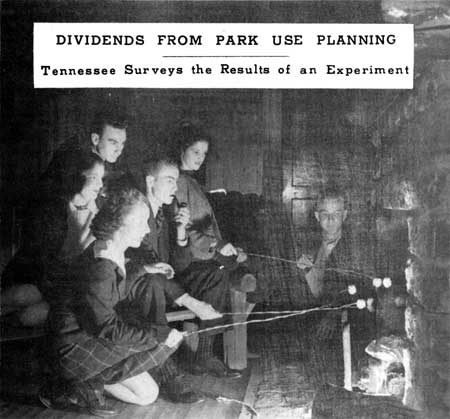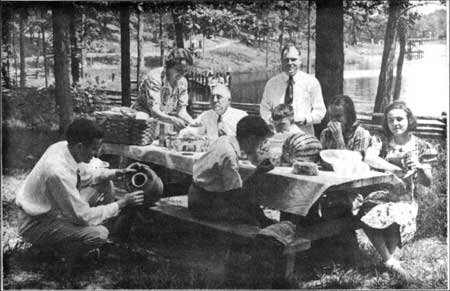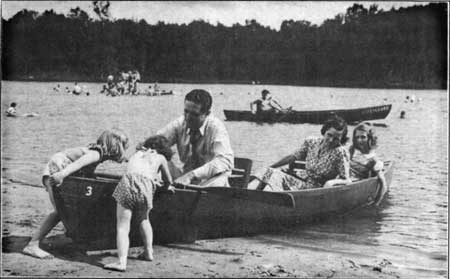|

BY WILLIAM HAY
Park Planner
Division of State Parks
Tennessee Department of Conservation
During the last two years Tennessee has been
experimenting with a planned program of stimulating and guiding the use
of its state parks through leadership and group contact activities.
Initiated tentatively in 1938, the program did not reach its full scope
until last year. Actual records now show that it almost doubled both
attendance and participation in activities and that it is rapidly
creating a park consciousness in the public mind.
In addition, it is helping to arouse a keener
interest in conservation by instilling a greater respect for nature in
the minds of thousands of park visitors by giving them enjoyable
experiences in the out-of-doors. As a result of the success of the
program, planned recreation has been accepted as a permanent
administrative policy of the Division of State Parks of the Department
of Conservation.
The program is not a hair-brained scheme plucked out
of thin air. It evolved slowly as a result of experience, observation
and careful study of the recreational habits and needs of the state's
population. It was based on a knowledge that a vast majority of
Tennessee's 2,600,000 people have had little opportunity to acquire
interests and skills in the out-door forms of recreation. It was
established through observation that park visitors were motivated
largely by curiosity rather than recreational interests. A large number
of these recorded during the first year stood around throughout their
stay, gaping wistfully at the few who engaged in activities. While some
of them no doubt were entertained by what they saw, as a spectator
enjoys his indirect participation in a ball game, the majority
nevertheless went away not to return---good evidence that the park was not providing
something which they went there to get. This led to a conclusion that,
if the parks were to afford the maximum use of each resource and each
facility, and if they were to serve the greatest number of persons, then
a certain amount of educational effort was needed to acquaint visitors
with recreational opportunities. We believed such work could be
accomplished only through a planned program of appropriate character
carried out under capable leadership.
Since the Division of State Parks was just initiating
its park operation and since funds were low and personnel inadequate,
it became necessary to look elsewhere for the leadership that was
required. Accordingly, when the director of the Work Projects
Administration's State Division of Recreation volunteered cooperation in
the establishment of a recreational program on the new park areas by
providing assistance from his administrative staff, which included
specialists, district supervisors and the director himself, his offer
was accepted eagerly. In addition, a man and woman leader were obtained
for each of the four areas which were open to the public. They were
furnished quarters at the park and placed under supervision of the park
superintendent. Besides providing leadership service, they acted as
good will ambassadors, assisting patrons in every manner possible,
especially in interpreting the features of the park and explaining the
extent of the program offered. The women leaders acted also as hostesses
at the lodge and other gathering points.

(click on image for an enlargement in a new window)
The program was planned to accomplish the following objectives:
(1) Give a maximum of suitable leisure-time activities to our people;
(2) Increase participation in activities;
(3) Increase general park attendance;
(4) Maintain a high rate of attendance during week-days and off-seasons;
(5) Establish the habit of repeat visits by patrons, and
(6) Utilize to the best advantage the natural resources of each of the state's parks.
The plan was inaugurated with the opening of the
first parks in July, 1938, but during the first year its scope was
limited to rendering the services already enumerated and to a careful
study of park patron habits and interests. At the close of the season
work was begun on the formulation of a year-around program. The
following steps were evolved and approached in the order of their sequence, the
field work being done by the park superintendent and a trained
recreation leader.
(1) A 15-, 25- and 50-mile highway zone was
established around each park in operation.
(2) The compilation of a list of all groups and
organizations functioning together as a body and lying within this
50-mile zone was begun. At the same time information concerning the
size, nature, time of regular meeting and type of program was obtained.
Whether the agency sponsored or participated in recreational activities
was recorded. Groups of divers types, such as luncheon clubs, social
clubs, 4-H Clubs, Home Demonstration Clubs, music clubs, Boy Scouts and
Girl Reserves, were included.
(3) Each group was contacted through its presiding
officer by mail or by personal interview of the park personnel. Letters
were used at first for the smaller and more remote groups to describe
the advantages of the park facilities and recreation program. They were
shown how their own program might be elaborated or stimulated by the
various activities of the park conducted under competent leadership.
Similar information was given to larger groups in talks by park
representatives. In many cases the lectures were illustrated with the state
park motion picture, The Dawn of a New Day, which depicts in natural
colors the activities enjoyed in the parks and shows how the
visitors engage in them. Many new recreational
pursuits thus were demonstrated for persons possessing varied interests.
Their curiosity and desire for such experiences were aroused.
(4) They then were invited to the park to engage in
some activity in which they already were well versed, or for some new
program. They became familiar gradually with the new
enterprise and eventually each group became independent to a great
extent as far as leadership at the area was concerned. Each person soon
sought his favorite activity on repeat visits.
(5) As each group contacted came to the area a
complete record was made of the number, age, sex, activities chosen, and
the extent of assistance given by the park personnel. A special record
was kept of each repeat visit when members of the group appeared
together.
(6) Informal groups and individuals coming to the
park were assisted in some activity and the leaders, though careful not
to impose their aid on the patron, were alert to help anyone showing
interest in some particular pursuit.
(7) District conferences for Work Projects
Administration leaders were held at several state parks. This not only
acquainted them with actual demonstrations of perk activities but also
caused them to take their enthusiasm and information back to the
communities in which they lived, thereby encouraging many more persons
in the use of the areas.
(8) Specialists from the state office of the Work
Projects Administration were assigned to state parks at intervals to
stimulate and promote interest in handcraft and social and other
activities.

The results achieved at Cedar of Lebanon State Park,
a typical area, illustrates the general effectiveness of the program.
During the first year (1938) of operation by the state the park had
little leadership and no community educational work. During the 1937
season, before the formal opening, less than 10 per cent of the visitors
engaged in activities and the attendance was low despite people's
curiosity concerning the new development.
In the 1938-39 season, recreational guidance in
activities was provided by a well trained leader and the park
superintendent. Group contact and community educational work had not
been carried on, however, before the fall of 1938. Participation in
activities that year was 53 per cent of the total attendance. In 1939,
after this plan had been set in action and group contact work was
carried on through the winter, participation increased to 84 per cent
of total attendance. Attendance itself increased 79 per cent.
A soft drink bottling firm may be cited to illustrate
the effects of this program on a typical group, and the advantages of
advanced planning. The president of the company, who was acquainted
with the park program, brought a group of 150 persons to the area. The
park superintendent and recreational leader prepared an all-day
program varied in nature and fitted to the interests of the group. As a
result of the success of the venture this park has been chosen for the
company's annual outing.
During the winter of 1938-39 one hundred sixty-seven
different organizations were contacted, forty-seven of them by personal
interview. Of the forty-seven, thirty-five came to the park during the
past summer. Of the 120 remaining groups, seventy-eight have visited the
park.
It is difficult to make statistical tabulations of
the entire results because, as is true in any creative work, there are
many intangible elements. The indirect effect of the group contact work
may be cited as an example. A good many of the individuals who came with
the various groups had never been to the park before. After the first
visit many of them returned a number of times, bringing their families
and friends, or a church, civic, social or school group to which they
belonged. At Cedar of Lebanon State Park 75 per cent of those in
attendance on a date when a check was taken were repeat visitors.
Due to the many elusive factors influencing a program
of this kind, no attempt has been made to show the cause and effects of
every step taken. We may conclude from the results shown to date,
however, that the plan is making a definite contribution to a more
widespread and intelligent use of our parks, and a more alert interest
in conservation.
Planned recreation has become a definite part of the
state park program in Tennessee. Present evidence indicates that it
provides a more effective method of conserving human resources and that,
at the same time, it decreases the danger of destroying scenic resources
. We feel, as do others who are close to our problem, that an
encouraging advance has been made toward solving the recreation
question in the state. It is felt that better service is being performed
for the public.
[All photographs by courtesy of the Tennessee Department of
Conservation]

| 
